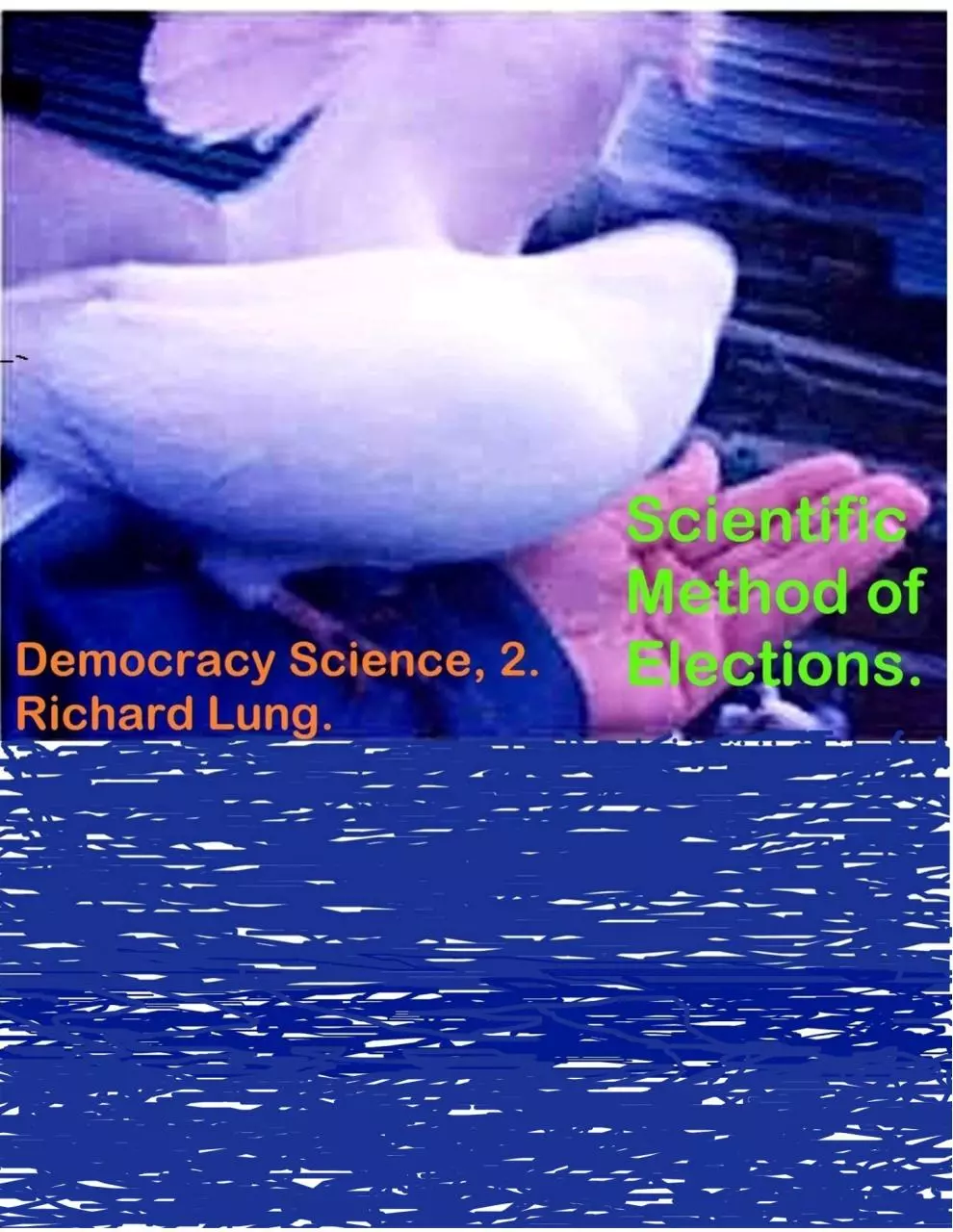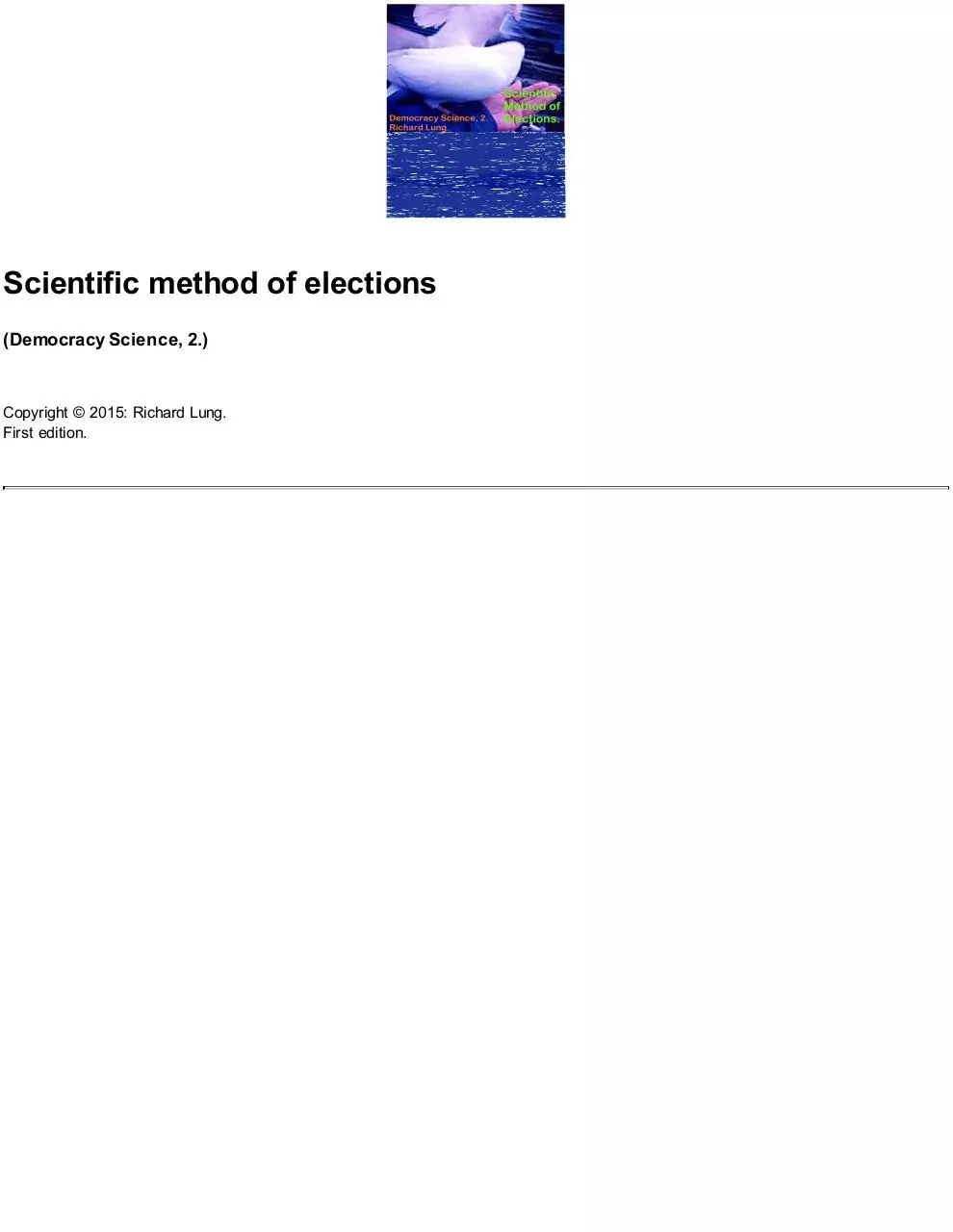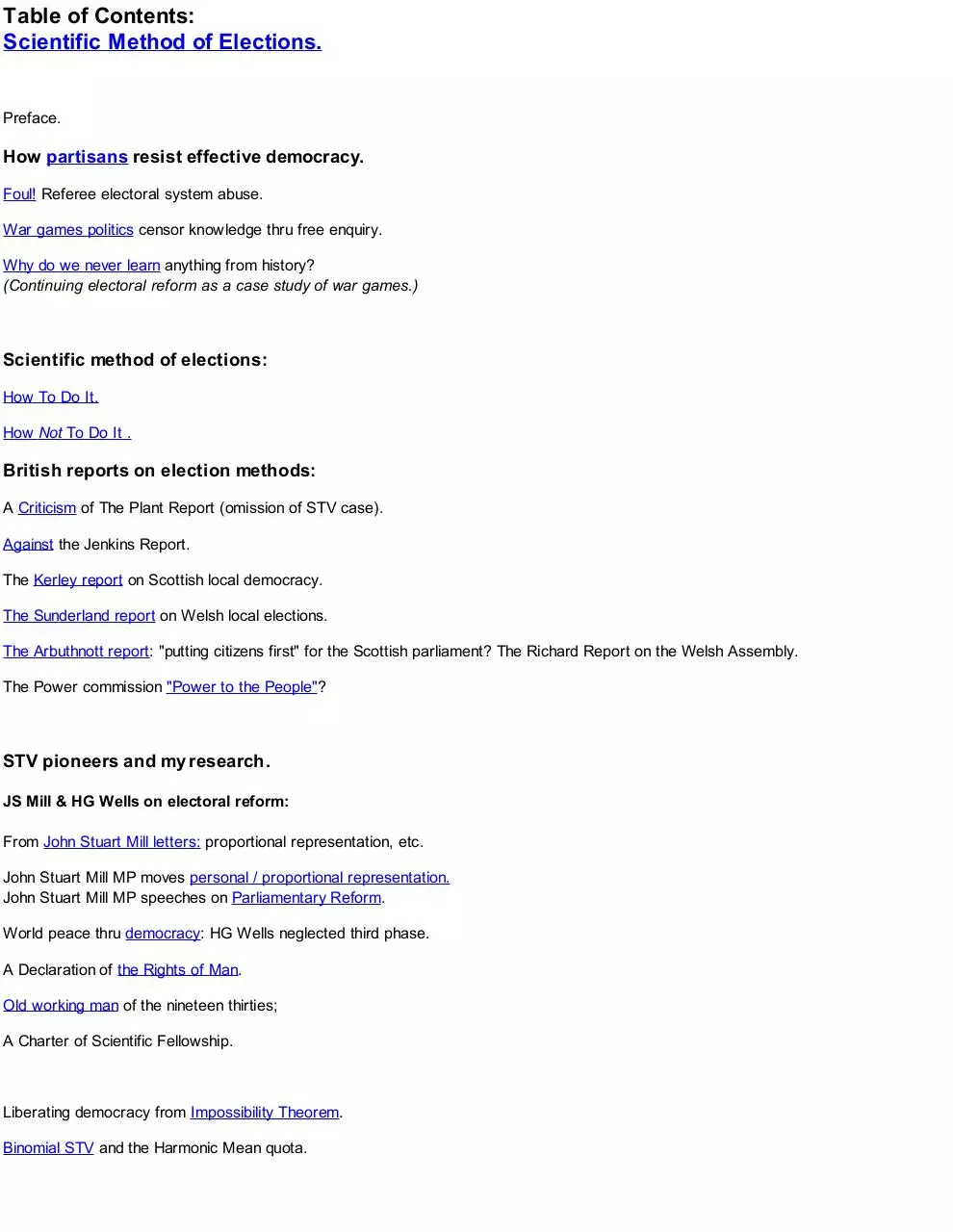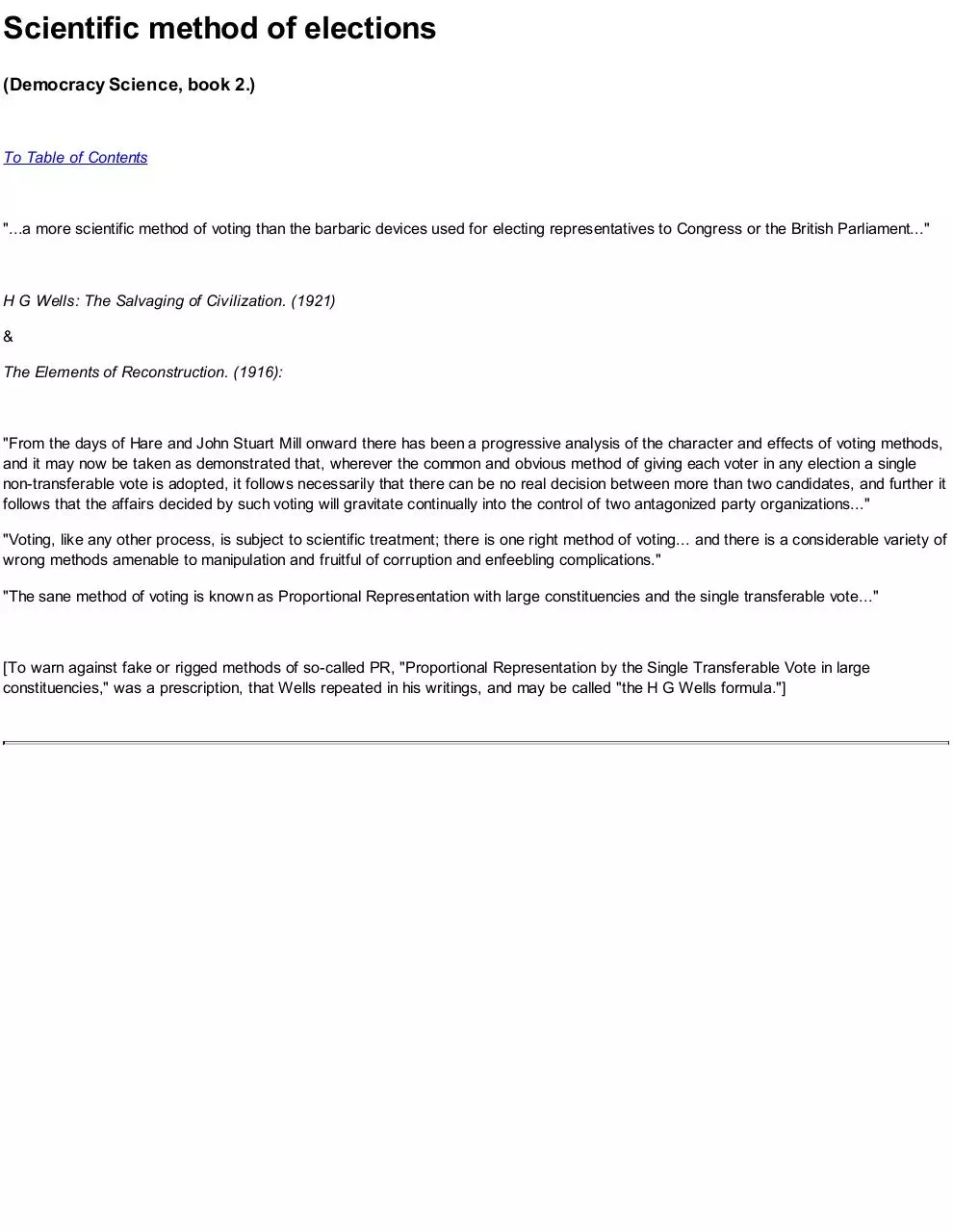Scientific method of elections (PDF)
File information
Title: Scientific method of elections.
Author: Richard Lung
This PDF 1.3 document has been generated by calibre (1.24.0) [http://calibre-ebook.com] / calibre 1.24.0 [http://calibre-ebook.com], and has been sent on pdf-archive.com on 22/08/2016 at 21:16, from IP address 77.44.x.x.
The current document download page has been viewed 1291 times.
File size: 3.44 MB (206 pages).
Privacy: public file





File preview
Scientific method of elections
(Democracy Science, 2.)
Copyright © 2015: Richard Lung.
First edition.
Table of Contents:
Scientific Method of Elections.
Preface.
How partisans resist effective democracy.
Foul! Referee electoral system abuse.
War games politics censor knowledge thru free enquiry.
Why do we never learn anything from history?
(Continuing electoral reform as a case study of war games.)
Scientific method of elections:
How To Do It.
How Not To Do It .
British reports on election methods:
A Criticism of The Plant Report (omission of STV case).
Against the Jenkins Report.
The Kerley report on Scottish local democracy.
The Sunderland report on Welsh local elections.
The Arbuthnott report: "putting citizens first" for the Scottish parliament? The Richard Report on the Welsh Assembly.
The Power commission "Power to the People"?
STV pioneers and my research.
JS Mill & HG Wells on electoral reform:
From John Stuart Mill letters: proportional representation, etc.
John Stuart Mill MP moves personal / proportional representation.
John Stuart Mill MP speeches on Parliamentary Reform.
World peace thru democracy: HG Wells neglected third phase.
A Declaration of the Rights of Man.
Old working man of the nineteen thirties;
A Charter of Scientific Fellowship.
Liberating democracy from Impossibility Theorem.
Binomial STV and the Harmonic Mean quota.
Guide to five volume collected verse
by Richard Lung
Guide to two more book series:
Commentaries series;
Democracy Science series.
Scientific method of elections
(Democracy Science, book 2.)
To Table of Contents
"...a more scientific method of voting than the barbaric devices used for electing representatives to Congress or the British Parliament..."
H G Wells: The Salvaging of Civilization. (1921)
&
The Elements of Reconstruction. (1916):
"From the days of Hare and John Stuart Mill onward there has been a progressive analysis of the character and effects of voting methods,
and it may now be taken as demonstrated that, wherever the common and obvious method of giving each voter in any election a single
non-transferable vote is adopted, it follows necessarily that there can be no real decision between more than two candidates, and further it
follows that the affairs decided by such voting will gravitate continually into the control of two antagonized party organizations..."
"Voting, like any other process, is subject to scientific treatment; there is one right method of voting... and there is a considerable variety of
wrong methods amenable to manipulation and fruitful of corruption and enfeebling complications."
"The sane method of voting is known as Proportional Representation with large constituencies and the single transferable vote..."
[To warn against fake or rigged methods of so-called PR, "Proportional Representation by the Single Transferable Vote in large
constituencies," was a prescription, that Wells repeated in his writings, and may be called "the H G Wells formula."]
Preface
The following chapters are based on writings from the previous quarter century and stem from earlier work, whose ideas had their origin in
my student years, nearly half a century ago. They are edited, augmented and up-dated from pages on my Democracy Science web-site,
since the turn of the millennium.
Book one, in the Democracy Science series, was “Peace-making Power-sharing.” This second book has more on electoral research, as
well as electoral reform, tho the difference is only one of emphasis. Indeed, book 1 ends with my first surviving scientific paper on voting
methods, from 1981 (over a third of a century ago, and in French).
But for the accident of being obliged to study the subject, in my youth, my mind-set confirmed “research, which shows that people think
very little about electoral systems.”
This might explain why there is such a confusion of different voting methods in the world.
However, the commission, “changed voting changed politics,” I’ve just quoted from, doesn’t come to this conclusion at all.
They say: To seek a perfect system that will achieve all legitimate objectives at all times and in all circumstances is to chase a rainbow.
You might as well say that theoretical science, which seeks to pick out right from wrong explanations, is just such chasing a rainbow. The
search for a universally valid voting method began in the French Enlightenment, followed by the British philosophical radicals. I prefaced this
book by quoting a categorical statement that there is a generally applicable voting method, even naming it “the HG Wells formula,” amongst
any number of wrong methods, offering ineffective choices.
The pioneering Australian electoral reformer, Catherine Helen Spence called this general method “effective voting,” which shows she saw
the essence of the problem and its solution.
Today, a disproportionate number of experts, considering its limited use in political elections, do favour essentially this system. Tho, the
majority of academics do not.
Richard Feynman observed that there is a lot of disagreement in sciences that haven’t advanced very far.
Election science is in so primitive a state that it can only agree to disagree. Part of the problem is the novice belief that it is sophisticated to
regard the universal standards of science, with respect to voting method, as chasing rainbows.
Thus, academe has legitimised the anarchy of voting methods in the world, as the best of all possible worlds. Dr Pangloss is the election
riggers friend.
For a century or more, partisan special interests have resisted the expression of the public interest by effective voting. A small sample of
this immense problem is given in the first three chapters. The subordination of the truth about election methods to partisan advantage is
rarely far away from any discussion of the subject.
The next two chapters on scientific method of elections are my attempts to put across the basics of the subject, following the widely
accepted logic of measurement to establish right voting method. This neglected approach (of mine) I’ve supplemented with philosophy of
science, on lessons from successful investigations.
In the following section, the quality of the British reports depended on whether or not they were truly independent, as well as their terms of
reference.
The Plant report was an internal Labour Party document that anticipated the above-mentioned point of view of the commission to over-see
changed voting, established by an ensuing Labour government.
Also set up by the Labour government, the Jenkins commission allegedly had been given power to recommend a voting reform for the
national parliament. It was also supposed to be independent but, behind-the-scenes, there was an effective veto of effective voting. Like
some show trial, the verdict had been reached in advance: a system nobody used, nobody asked-for, and nobody really wanted.
The Kerley report and the Sunderland report on local elections in Scotland and Wales were not directly under the national government, and
decided for effective voting. As did the Richard report for elections to the Welsh assembly. The latter was over-ruled by Westminster. This
probably made the Arbuthnott report more diffident towards effective voting for the Scottish parliament, tho they did recommend it for
Scottish Euro-elections, in conformity with its introduction to Scottish local elections, on the recommendation of the Kerley report.
The Power report, chaired by Helena Kennedy, had much to say about the disaffection with politics, and even ventured a remark favorable
to effective voting. The House of Lords debate showed that its findings were not sufficient to burst “the Westminster bubble”of
complacency towards the public mood about politics.
The final section is in two parts. Firstly, the pioneers: speeches and letters on parliamentary representation by John Stuart Mill. Plus a
bibliography of HG Wells writings on electoral reform and occupational representation. The two human rights charters, he initiated, are also
shown.
The second part is a chapter assessing social choice theory and another chapter explaining my own research into refinements of effective
voting.
How partisans resist effective democracy.
To Table of Contents
"It will be particularly interesting to watch the ingenuities of the politicians in the new Parliament in producing schemes that will look like
electoral reform and yet leave the profession still active for mischief. They will fight desperately against large constituencies with numerous
members. The one member or two-member constituency is absolutely necessary to their party system. In such constituencies even
proportional representation can be reduced to a farce.
And also they will offer cheap but attractive substitutes like the second ballot and the alternative vote. And they will fake extraordinary
arrangements by which the voter will vote not for an individual but for a ticket or bunch, and they will call these fakes this or that improved
variety of 'proportional representation.'....
The discussion of electoral legislation in ... Parliament throughout the next session, though it may make the angels weep, is certain to
afford much entertainment to every mundane observer of human disingenuousness."
H G Wells: A Year of Prophesying. (1924).
Foul! Referee electoral system abuse.
To Table of Contents
Links to sections:
Introduction.
The Speakers Conferences on electoral reform.
Royal Commisions.
Extra-parliamentary campaigns.
Select Committee.
Constitutional Courts.
Conclusion: Elected vocational second chamber referee.
Introduction
No one questions the need for referees in sport, tho we often have cause to grumble at their decisions, because the ref is human and
fallible like the rest of us. We used to call a "sportsman" someone who put fair play before their self-glorification. Opinion polls continually
show politicians to be among the least trusted professions.
Just over twenty years after the Royal Commission on standards of conduct in public life, in 1976, another body was set up to investigate
sleaze. An academic described the public view of politicians as people who put their party before everyone else but themselves.
He went on to remark that people seemed remarkably tolerant of this.
But there is a saying: What cannot be cured must be endured.
At issue here is not the gross corruption that the courts are empowered to deal with. Nevertheless, it is a kind of cheating, if governing
parties keep or make the rules of the game to suit themselves. In particular, the courts may not decide what are fair rules of the electoral
contest. Yet does a nation need some referee, independent of the government, so the voting procedure is fair?
The evidence is overwhelming that parties, competing for power, need refereeing. Coming to power does not make them fit judges of their
own cause. Rather, as Lord Acton said, power corrupts. Trying to give an idea, of how far "gerrymandered voting methods" (as H G Wells
called them) prevail, is a bit like attempting a history of sin.
Like pollution, it became a common-place we may not even be aware of.
The British Labour party Plant report argued there was no standard of voting method. The report was noticably slighting of proportional
representation pioneer, J S Mill, who wrote a book on methodology, System of Logic, that was a university text for fifty years.
The mathematician and Liberal statesman, Carl Andrae introduced preference voting with proportional or quota counting (the single
transferable vote) to his native Denmark.
Much credit must go to generous support from the leading nineteenth century philosopher of science, and independent Liberal, John Stuart
Mill. He entered parliament to introduce bills for the legal equality of women, including the suffrage, and "Mr Hare's system" of "Personal
Representation."
Andrae became a member of the Proportional Representation Society, founded in 1884, after a failure to implement PR in the Third
Reform Bill. This caused another mathematician, Leonard Courtney, from Cambridge university, to resign as minister in the Liberal
government.
The Proportional Representation Society of Australia saw some of the earliest progress for the campaign. In 1909, Tasmania was the first
state to use STV, known there as the Hare-Clark system.
My case for "Scientific method of elections" concluded that Carl Andrae and Thomas Hare independently invented the essentials of
Download Scientific method of elections
Scientific_method_of_elections.pdf (PDF, 3.44 MB)
Download PDF
Share this file on social networks
Link to this page
Permanent link
Use the permanent link to the download page to share your document on Facebook, Twitter, LinkedIn, or directly with a contact by e-Mail, Messenger, Whatsapp, Line..
Short link
Use the short link to share your document on Twitter or by text message (SMS)
HTML Code
Copy the following HTML code to share your document on a Website or Blog
QR Code to this page

This file has been shared publicly by a user of PDF Archive.
Document ID: 0000415276.